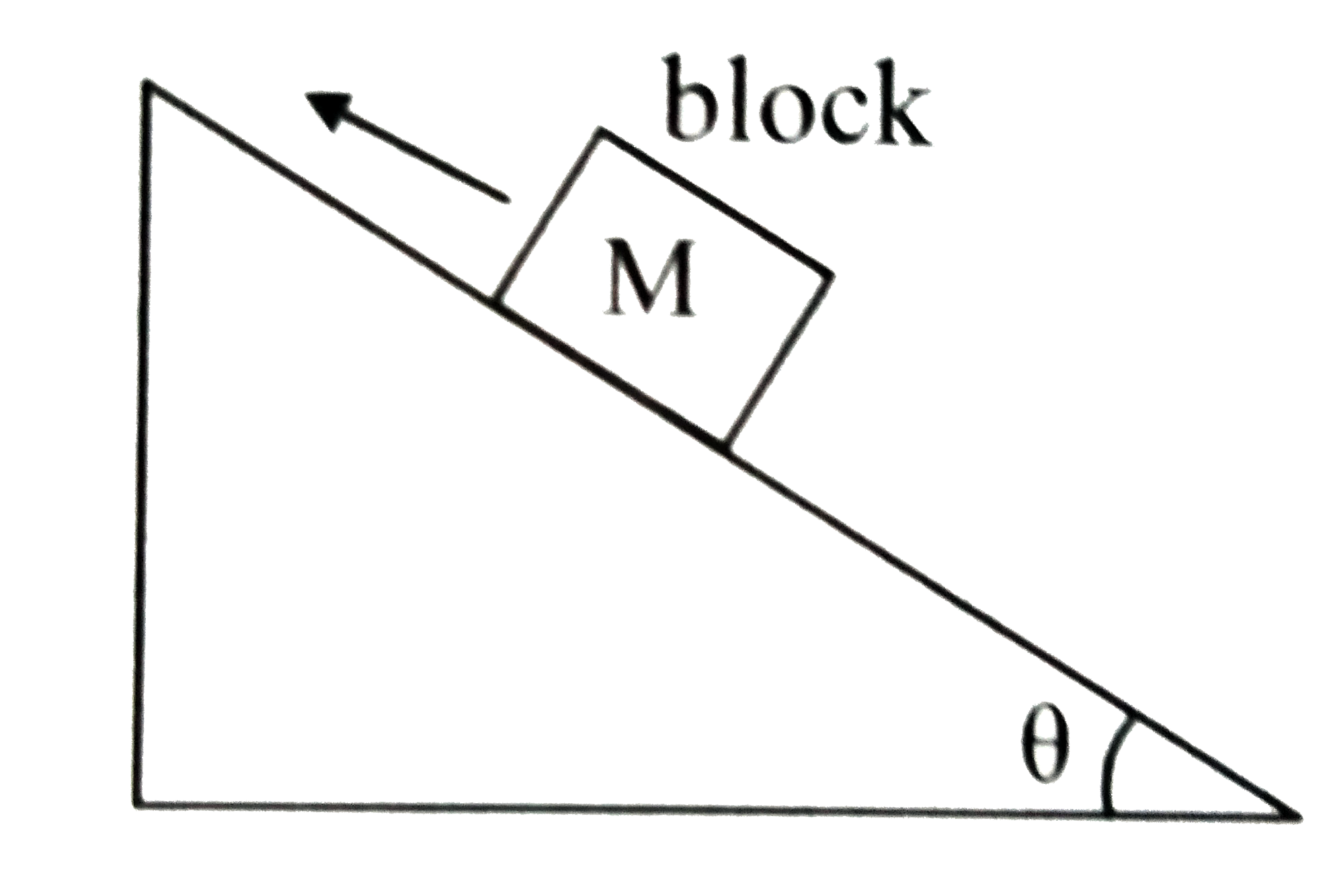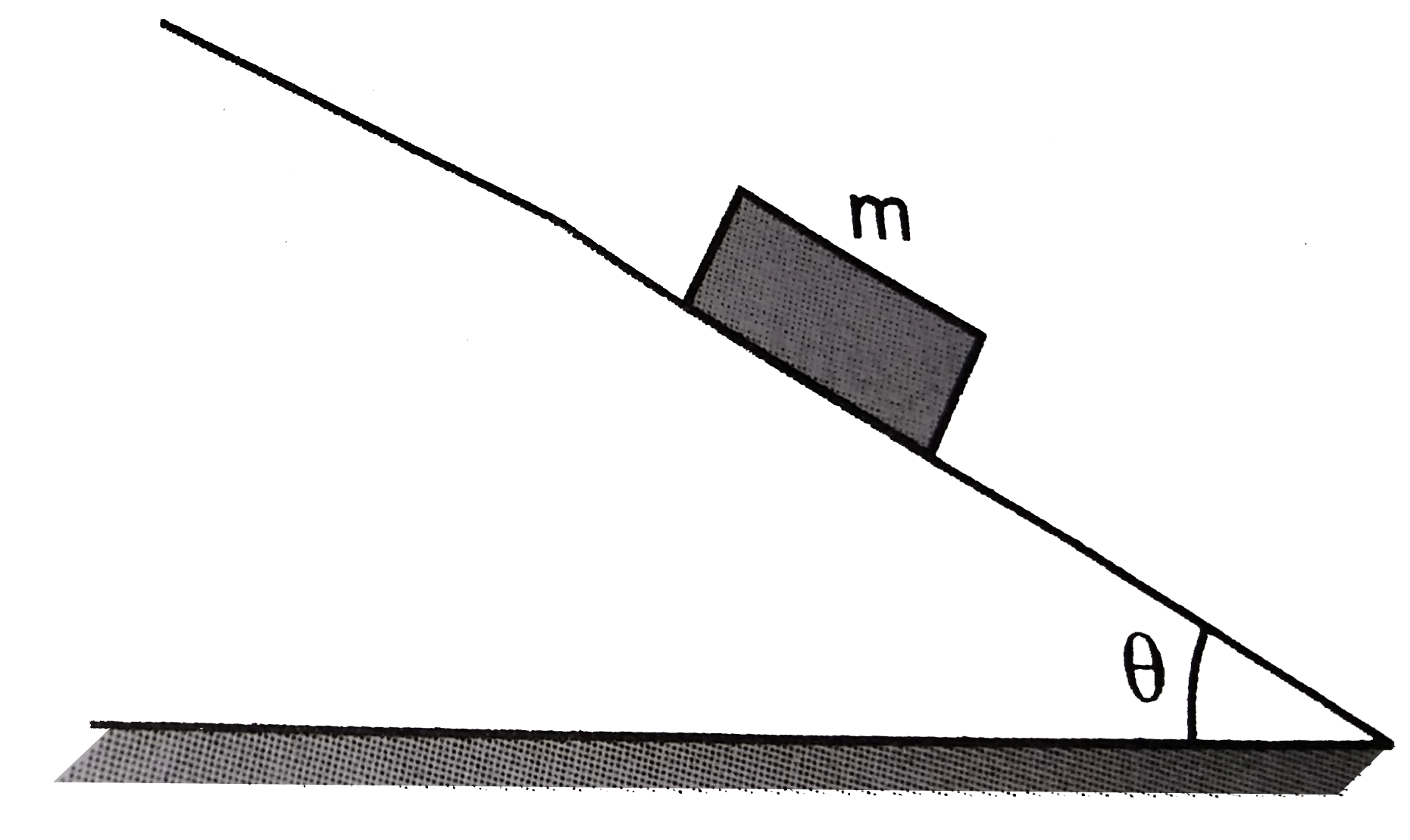A box of mass 4 kg rests upon an inclined plane. The inclination of the plane to the horizontak is gradually increased. It is found that when the slope of the plane is 1 in 3, the box starts sliding down the plane. Given g=9.8ms−2. Find the coefficient of friction between the box and the plane.
To solve the problem, we will follow these steps:
Step 1: Understand the Geometry of the Inclined Plane
The slope of the plane is given as 1 in 3. This means that for every 3 units of horizontal distance, the vertical height increases by 1 unit. Therefore, we can find the angle of inclination (θ) using the tangent function:
tan(θ)=oppositeadjacent=13
Step 2: Calculate the Angle of Inclination
To find the angle θ, we can use the arctangent function:
θ=tan−1(13)
Step 3: Identify Forces Acting on the Box
When the box is on the incline, the forces acting on it are:
- The gravitational force (weight) acting downwards, W=mg
- The normal force N acting perpendicular to the surface of the incline
- The frictional force f acting up the incline
Step 4: Calculate the Weight of the Box
Given the mass of the box m=4kg and g=9.8m/s2:
W=mg=4kg×9.8m/s2=39.2N
Step 5: Resolve the Weight into Components
The weight can be resolved into two components:
- Parallel to the incline: W∥=Wsin(θ)
- Perpendicular to the incline: W_{\perpendicular} = W \cos(\theta)
Step 6: Write the Equations for Forces
At the angle of inclination where the box starts sliding, the frictional force is at its maximum and can be expressed as:
f=μN
Where μ is the coefficient of friction. The normal force N is equal to the perpendicular component of the weight:
N = W_{\perpendicular} = W \cos(\theta)
The box starts sliding when the downhill force (parallel component of weight) equals the frictional force:
W∥=f
Step 7: Substitute the Forces
Substituting the expressions for W∥ and f:
Wsin(θ)=μWcos(θ)
Step 8: Simplify the Equation
Since W is common on both sides, we can cancel it out (assuming W≠0):
sin(θ)=μcos(θ)
Step 9: Solve for the Coefficient of Friction
Rearranging gives:
μ=sin(θ)cos(θ)=tan(θ)
Step 10: Calculate the Coefficient of Friction
Using the value of tan(θ):
μ=tan(tan−1(13))=13
Final Answer
The coefficient of friction between the box and the plane is:
μ=13≈0.33
---
The slope of the plane is given as 1 in 3. This means that for every 3 units of horizontal distance, the vertical height increases by 1 unit. Therefore, we can find the angle of inclination (θ) using the tangent function:
To find the angle θ, we can use the arctangent function:
When the box is on the incline, the forces acting on it are:
- The gravitational force (weight) acting downwards, W=mg
- The normal force N acting perpendicular to the surface of the incline
- The frictional force f acting up the incline
Given the mass of the box m=4kg and g=9.8m/s2:
The weight can be resolved into two components:
- Parallel to the incline: W∥=Wsin(θ)
- Perpendicular to the incline: W_{\perpendicular} = W \cos(\theta)
At the angle of inclination where the box starts sliding, the frictional force is at its maximum and can be expressed as:
N = W_{\perpendicular} = W \cos(\theta)
Substituting the expressions for W∥ and f:
Since W is common on both sides, we can cancel it out (assuming W≠0):
Rearranging gives:
Using the value of tan(θ):
The coefficient of friction between the box and the plane is:
Topper's Solved these Questions
Similar Questions
A block of mas M is resting on an inclined plane as shown in the figure. The inclination of the plane to the horizontal is gradually increased. It is found that when the angle of inclination is θ the block just begins to slide down the plane. What is the minimum force F applied parallel to the plane that would just make the block move up the plane ?
 View Solution
View SolutionA block of mas M is resting on an inclined plane as shown in the figure. The inclination of the plane to the horizontal is gradually increased. It is found that when the angle of inclination is θ the block just begins to slide down the plane. What is the minimum force F applied parallel to the plane that would just make the block move up the plane ?
 View Solution
View Solution
Knowledge Check
- Question 1 - Select One
A block of mass 4kg rests on an an inclined plane. The inclination of the plane is gradually increased. It is found that when the inclination is 3 in 5 (sinθ=35) the block just begins to slide down the plane. The coefficient of friction between the block and the plane is.
A0.4B0.6C0.8D0.75 - Question 2 - Select One
A block of mass m is resting on an inclined plane. The inclination of the plane to the horizontal is gradually increased. It is found that when angle of inclination is θ, the block just begins to slide down the plane. What is the minimum force F applied parallel to the plane that would just make the block move up the plane?
A2mgsinθBmgsinθCmgcosθD2mgcosθ - Question 3 - Select One
A block is stationary on an inclined plane If the coefficient of friction between the block and the plane is μ then
 .Aμ>tanθBf=mgsinθCf=μmgcosθDthe reaction of the ground on the block is mg cos θ
.Aμ>tanθBf=mgsinθCf=μmgcosθDthe reaction of the ground on the block is mg cos θ
A box of mass 4kg rests upon an inclined plane This inclination is gradually incresed till the box starts sliding down the plane. At this stage slope of the plane is 1 in 3 Find coefficient of friction between the box and the plane What force applied to the box parallel to the plane will just make the box move up the plane ?
View SolutionA box is lying on an inclined plane if the box slides when the angle of inclination is 60∘ then the coefficient of static friction of the box and the plane is?
View SolutionA block of mass 5 kg is placed on a rough inclined plane. The inclination of the plane is gradually increased till the block just begins to slide down. The inclination of the plane is than 3 in 5. The coefficient of friction between the block and the plane is (Take, g=10m/s2)
View SolutionA block is at rest on an inclined plane making an angle α with the horizontal . As the angle α of the incline is increased the block starts slipping when the angle of inclination becomes θ. The coefficient of static friction between the block and the surface of the inclined plane is or A body starts sliding down at an angle θ to the horizontal. Then the coefficient of friction is equal to
View SolutionA block of mass m rests on a rough inclined plane. The coefficient of friction between the surface and the block is µ. At what angle of inclination θ of the plane to the horizontal will the block just start to slide down the plane?
View Solution
